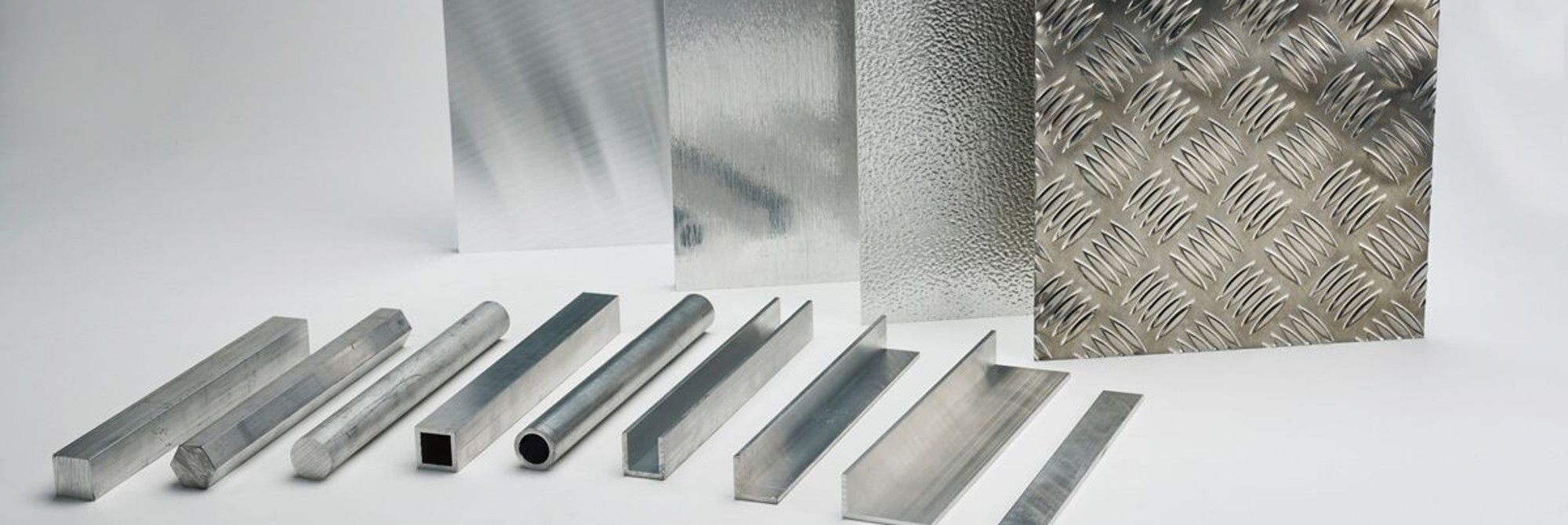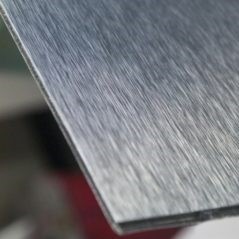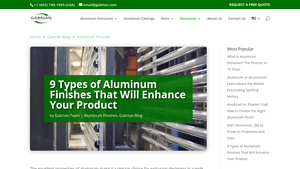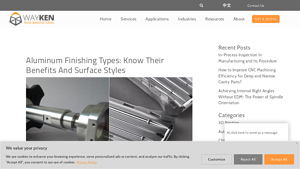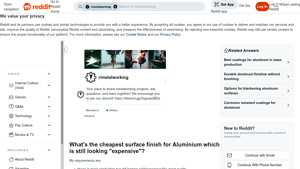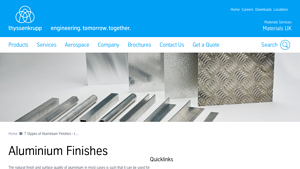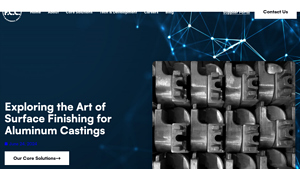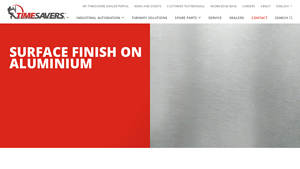Aluminium Surface Finish Guide: Type, Cost, Top List…
Introduction: Navigating the Global Market for aluminium surface finish
In the fast-evolving landscape of global manufacturing, sourcing high-quality aluminium surface finishes presents a significant challenge for B2B buyers, particularly in regions like Africa, South America, the Middle East, and Europe. The choice of surface finish can profoundly impact not only the aesthetic appeal of products but also their durability and functionality. This guide aims to demystify the various types of aluminium surface finishes, from anodizing to powder coating, and their applications across industries.
By exploring the nuances of each finishing technique, buyers will gain insights into selecting the right finish that aligns with their specific project requirements. Additionally, we will address critical factors such as supplier vetting, cost considerations, and the importance of adherence to international quality standards.
With a focus on providing actionable insights and practical advice, this comprehensive resource empowers international B2B buyers to make informed decisions, enhancing their procurement strategies and ensuring that their aluminium products meet both performance and aesthetic expectations. Whether you’re navigating the complexities of sourcing in Vietnam or evaluating suppliers in Germany, this guide equips you with the knowledge necessary to thrive in the competitive global market for aluminium surface finishes.
Understanding aluminium surface finish Types and Variations
| Type Name | Key Distinguishing Features | Primary B2B Applications | Brief Pros & Cons for Buyers |
|---|---|---|---|
| Anodizing | Electrochemical process creating a durable oxide layer | Aerospace, automotive, architectural | Pros: Excellent corrosion resistance, aesthetic appeal. Cons: Higher cost than some alternatives. |
| Powder Coating | Electrostatic application of a protective powder coating | Consumer goods, outdoor furniture | Pros: Environmentally friendly, vibrant colors. Cons: May show texture, less durable than anodizing. |
| Alodine Finish | Chemical treatment for corrosion resistance | Military, electronics, automotive | Pros: Cost-effective, good conductivity. Cons: Less durable than anodizing, limited aesthetic options. |
| Bead Blasting | Mechanical process using abrasive media for a textured finish | Industrial equipment, architectural elements | Pros: Smooth finish, removes impurities. Cons: May not provide significant corrosion resistance. |
| As Machined Finish | Original state post-machining, no additional treatment | Prototyping, low-cost applications | Pros: Cost-effective, tight tolerances. Cons: Visible machining marks, limited aesthetic appeal. |
What Are the Key Characteristics of Anodizing?
Anodizing is a widely utilized surface finish that enhances aluminum’s natural properties. This electrochemical process forms a thick oxide layer that not only improves corrosion resistance but also allows for a variety of aesthetic options, including vibrant colors. Anodized surfaces are particularly suitable for applications in aerospace and automotive sectors, where durability and appearance are paramount. Buyers should consider the thickness of the anodized layer, as it directly impacts the finish’s longevity and performance, especially in harsh environments.
How Does Powder Coating Enhance Aluminum Products?
Powder coating is an effective method for applying a decorative and protective finish to aluminum. This process uses electrostatic charges to adhere powdered paint to the surface, which is then cured to create a hard, durable layer. Commonly used in consumer goods and outdoor furniture, powder coating offers a wide range of colors and finishes. While it is more environmentally friendly than traditional painting methods, buyers should be aware that the texture may vary and that it may not be as durable as anodizing in extreme conditions.
Why Choose Alodine Finish for Specific Applications?
Alodine finish, also known as chemical film or chromate conversion coating, provides a cost-effective solution for enhancing aluminum’s corrosion resistance. This treatment is particularly beneficial in industries like military and electronics, where electrical conductivity is crucial. While it offers decent protection against corrosion, it lacks the durability of anodizing. Buyers should weigh the cost benefits against the potential need for additional protective measures, especially in demanding environments.
What Are the Advantages of Bead Blasting?
Bead blasting is a mechanical finishing process that uses abrasive media to clean and texture aluminum surfaces. This method is ideal for achieving a smooth, satin-like finish, making it popular in industrial applications and architectural designs. While bead blasting effectively removes surface impurities, it does not inherently provide corrosion resistance. Buyers should consider the intended application and whether additional protective finishes are necessary after bead blasting.
When Should You Consider As Machined Finish?
The as-machined finish is the raw state of aluminum after machining, requiring no further treatment. This option is often favored for prototypes or applications where cost-effectiveness is crucial. While it allows for tight tolerances and quick production, the visible machining marks may detract from aesthetic appeal. Buyers should assess the importance of appearance versus cost when considering this finish for their projects.
Key Industrial Applications of aluminium surface finish
| Industry/Sector | Specific Application of aluminium surface finish | Value/Benefit for the Business | Key Sourcing Considerations for this Application |
|---|---|---|---|
| Automotive | Anodized aluminum components for vehicle exteriors | Enhances corrosion resistance and aesthetic appeal, ensuring longevity and customer satisfaction | Compliance with automotive standards and specifications for durability and safety |
| Construction | Powder-coated aluminum window frames | Provides weather resistance and aesthetic customization, contributing to energy efficiency | Availability of diverse color options and coatings that meet local environmental regulations |
| Electronics | Chem film on aluminum heat sinks | Improves thermal conductivity and corrosion resistance, optimizing performance and lifespan | Technical specifications for thermal management and compatibility with electronic components |
| Aerospace | Anodized aluminum structural components | Increases strength-to-weight ratio and resistance to harsh environments, essential for safety and performance | Adherence to strict aerospace standards and certifications for material quality |
| Consumer Goods | Bead blasted aluminum housings for appliances | Achieves a visually appealing finish while enhancing durability and wear resistance | Consideration of manufacturing lead times and surface finish consistency for mass production |
How is Aluminium Surface Finish Used in the Automotive Industry?
In the automotive sector, anodized aluminum components are widely used in vehicle exteriors, such as trim and frames. This finishing process significantly enhances corrosion resistance and provides a visually appealing surface that can withstand harsh environmental conditions. Buyers in this industry need to ensure that their suppliers comply with automotive standards, focusing on durability and safety to meet regulatory requirements. The anodized finish not only improves the aesthetics of vehicles but also contributes to their longevity, ultimately enhancing customer satisfaction and brand loyalty.
What Role Does Aluminium Surface Finish Play in Construction?
In construction, powder-coated aluminum window frames are a popular choice due to their combination of aesthetic appeal and functional durability. The powder coating provides excellent weather resistance, which is crucial for outdoor applications, while also allowing for a variety of color options to match architectural designs. Buyers must consider local environmental regulations regarding coatings and ensure their suppliers can deliver products that meet these standards. The energy efficiency benefits of powder-coated frames can also be a selling point for builders aiming to meet modern energy codes.
How is Aluminium Surface Finish Beneficial in Electronics?
In the electronics industry, chem film finishes on aluminum heat sinks are essential for improving thermal conductivity and corrosion resistance. This type of surface treatment ensures that heat dissipation is optimized, which is critical for the performance and longevity of electronic devices. International buyers must pay close attention to technical specifications related to thermal management and ensure compatibility with other electronic components. The reliability of these finishes directly impacts the performance of electronic products, making sourcing from reputable suppliers vital.
Why is Aluminium Surface Finish Important in Aerospace?
Aerospace applications often utilize anodized aluminum structural components to leverage their superior strength-to-weight ratio and resistance to extreme environments. This surface finish is critical for safety and performance, as it enhances the material’s durability against corrosion and wear. Buyers in the aerospace sector must ensure that their suppliers adhere to stringent aerospace standards and certifications, as the consequences of material failure can be catastrophic. The anodized finish not only meets functional requirements but also contributes to the overall efficiency of aircraft design.
How Does Aluminium Surface Finish Enhance Consumer Goods?
In the consumer goods sector, bead blasted aluminum housings for appliances provide a visually appealing and durable finish. This surface treatment not only enhances the aesthetic quality of products but also improves their resistance to wear and tear, increasing their lifespan. Buyers should consider manufacturing lead times and the consistency of surface finishes when sourcing these components, especially for mass production. The combination of durability and visual appeal can significantly influence consumer purchasing decisions, making it imperative for manufacturers to prioritize high-quality finishes.
3 Common User Pain Points for ‘aluminium surface finish’ & Their Solutions
Scenario 1: Ensuring Consistent Quality Across Multiple Suppliers
The Problem: B2B buyers often face the challenge of inconsistent quality when sourcing aluminium surface finishes from multiple suppliers. This inconsistency can lead to variations in color, texture, and durability, which ultimately affects the final product’s aesthetic and functional performance. Such discrepancies can result in increased costs due to rework, returns, and damage to brand reputation, especially when dealing with high-stakes projects or clients.
The Solution: To overcome this issue, it is essential to establish a standardized set of specifications for aluminium surface finishes that can be communicated to all suppliers. This includes detailing the exact finish type (e.g., anodizing, powder coating), the required thickness of coatings, and specific color codes using recognized standards like RAL or Pantone. Buyers should also conduct initial audits of potential suppliers to assess their finishing capabilities and quality control processes. Building strong relationships with a select number of suppliers who can consistently meet your specifications will further enhance quality assurance. Regularly scheduled quality checks and samples should be part of the procurement process to ensure that every batch meets the set standards.
Scenario 2: Managing Corrosion Resistance in Diverse Environments
The Problem: Buyers in industries such as construction or automotive may encounter the issue of inadequate corrosion resistance in aluminium products, particularly when these products are exposed to harsh environmental conditions. If the surface finish is not suited to the specific environmental factors (such as humidity, salt exposure, or industrial pollutants), it can lead to premature failure of the components, resulting in costly repairs and replacements.
The Solution: To address this pain point, it is critical to conduct a thorough analysis of the environmental conditions where the aluminium products will be used. Based on this assessment, buyers should select appropriate surface finishes that offer enhanced corrosion resistance. For instance, anodizing provides a robust oxide layer that enhances durability in corrosive environments, while powder coating can offer both aesthetic appeal and protective qualities. Collaborating with surface finishing experts can provide additional insights into selecting the right finish and applying it correctly to maximize performance. Furthermore, specifying post-treatment care, such as regular maintenance schedules, can prolong the lifespan of the finished aluminium products.
Scenario 3: Navigating the Complexity of Finish Selection
The Problem: Many B2B buyers struggle with the complexity of choosing the right aluminium surface finish, given the multitude of options available, each with its unique properties and applications. This confusion can lead to selecting an unsuitable finish that may not meet the functional requirements of the project, resulting in performance issues and wasted resources.
The Solution: To simplify the decision-making process, buyers should first establish a clear understanding of the specific requirements of their project, including aesthetic preferences, functional needs, and environmental considerations. Creating a decision matrix that compares the properties of different finishes—such as anodizing, powder coating, and chem film—against these requirements can help in making informed choices. Additionally, engaging with technical representatives from finishing companies can provide valuable insights and recommendations tailored to your needs. It may also be beneficial to conduct small-scale trials of different finishes on sample parts to evaluate their performance before committing to larger orders. By taking a structured approach to finish selection, buyers can ensure that their final choices align with their project goals, enhancing both performance and satisfaction.
Strategic Material Selection Guide for aluminium surface finish
What Are the Key Properties of Common Aluminium Surface Finishes?
When selecting an aluminium surface finish, it is essential to consider the specific properties that will impact product performance. Here, we explore four common finishes: anodizing, powder coating, alodine (chem film), and bead blasting, analyzing their key properties, advantages, disadvantages, and implications for international B2B buyers.
Anodizing: A Durable and Aesthetically Pleasing Option
Anodizing is an electrochemical process that enhances the natural oxide layer on aluminium, providing excellent corrosion resistance and durability. Key properties include a temperature rating of up to 100°C and high resistance to wear and abrasion.
Pros: Anodizing offers a long-lasting finish that is aesthetically appealing and available in various colors. It improves electrical insulation and is ideal for outdoor applications due to its resistance to UV light.
Cons: The anodizing process can be more expensive than other finishes and may require specific environmental controls during application. Additionally, it may not be suitable for applications requiring high electrical conductivity.
Impact on Application: Anodized surfaces are compatible with harsh environments, making them suitable for aerospace, automotive, and architectural applications.
Considerations for International Buyers: Compliance with standards such as ASTM B580 and DIN 17611 is crucial. Buyers from regions like Africa and South America should ensure that suppliers can meet these standards to avoid quality issues.
Powder Coating: A Versatile and Eco-Friendly Finish
Powder coating involves applying a dry powder to the aluminium surface, which is then cured under heat to form a hard finish. It provides excellent resistance to chipping, scratching, and fading.
Pros: This finish is highly customizable in terms of color and texture, making it suitable for decorative applications. It is also more environmentally friendly compared to liquid paints, as it contains no solvents.
Cons: While powder coating is durable, it may not adhere well to surfaces that are not properly pre-treated. Additionally, the curing process requires significant energy input.
Impact on Application: Powder-coated aluminium is commonly used in outdoor furniture, automotive parts, and architectural elements due to its weather resistance.
Considerations for International Buyers: Buyers should confirm that the powder coating process adheres to local regulations regarding VOC emissions and environmental standards, particularly in Europe.
Alodine (Chem Film): Cost-Effective Corrosion Resistance
Alodine, or chem film, is a chemical conversion coating that enhances corrosion resistance while maintaining electrical conductivity. It is typically used in aerospace and military applications.
Pros: Alodine is a cost-effective alternative to anodizing and provides good corrosion resistance without significantly altering the electrical properties of the aluminium.
Cons: While it offers decent protection, it is not as durable as anodizing and may require periodic reapplication in harsh environments.
Impact on Application: Alodine is suitable for applications where electrical conductivity is crucial, such as in electronic housings and connectors.
Considerations for International Buyers: Compliance with military specifications (e.g., MIL-DTL-5541) is essential for buyers in the aerospace and defense sectors, particularly in the Middle East.
Bead Blasting: A Mechanical Finish for Aesthetic Appeal
Bead blasting uses high-pressure abrasive media to create a smooth, uniform surface on aluminium components. This finish is often used for aesthetic purposes.
Pros: Bead blasting provides a consistent surface finish that can enhance the appearance of aluminium parts without altering their dimensions significantly.
Cons: While it improves aesthetics, bead blasting does not provide significant protection against corrosion or wear, making it less suitable for functional applications.
Impact on Application: This finish is ideal for decorative components in consumer products, such as electronics and appliances.
Considerations for International Buyers: Buyers should ensure that bead blasting processes meet specific surface finish requirements outlined in standards such as JIS B 0601 for surface roughness.
Summary Table of Aluminium Surface Finishes
| Material | Typical Use Case for aluminium surface finish | Key Advantage | Key Disadvantage/Limitation | Relative Cost (Low/Med/High) |
|---|---|---|---|---|
| Anodizing | Aerospace, automotive, architectural | Excellent corrosion resistance | Higher cost and environmental controls | High |
| Powder Coating | Outdoor furniture, automotive parts | Highly customizable and eco-friendly | Requires proper surface pre-treatment | Medium |
| Alodine (Chem Film) | Aerospace, military applications | Cost-effective with good conductivity | Less durable than anodizing | Low |
| Bead Blasting | Decorative components in consumer products | Consistent aesthetic finish | Limited corrosion protection | Low |
This strategic material selection guide provides valuable insights for B2B buyers, aiding in the decision-making process when choosing the appropriate aluminium surface finish for their specific applications.
In-depth Look: Manufacturing Processes and Quality Assurance for aluminium surface finish
What Are the Key Stages in the Manufacturing Process of Aluminum Surface Finishes?
The manufacturing process of aluminum surface finishes is intricate and involves several critical stages. Understanding these stages can help B2B buyers make informed decisions when selecting suppliers.
1. Material Preparation
Before any surface finishing can occur, the aluminum must undergo thorough preparation. This involves:
- Material Selection: Choosing the right aluminum alloy based on the intended application. Factors such as strength, weight, and corrosion resistance play a significant role.
- Cleaning: The aluminum surface is cleaned to remove any contaminants, oils, or residues. This is often done using chemical baths or ultrasonic cleaning to ensure a pristine surface.
- Surface Treatment: Depending on the required finish, a pre-treatment may be applied. This could include etching or anodizing to enhance adhesion for subsequent coatings.
2. Forming
Once the material is prepared, the next stage is forming, which may involve:
- Extrusion: In many cases, aluminum is extruded into specific shapes that meet design requirements. This process can create complex geometries efficiently.
- Machining: For precision components, CNC machining is employed to achieve tight tolerances and desired surface roughness.
- Bending and Assembly: Some applications require bending or assembling multiple aluminum components, which may involve welding or fastening.
3. Finishing
Finishing is where the aluminum’s aesthetics and performance characteristics are enhanced. Common finishing techniques include:
- Anodizing: This electrochemical process increases corrosion resistance and allows for color customization. It creates a durable oxide layer that is integral to the aluminum substrate.
- Powder Coating: A popular choice for decorative finishes, powder coating involves applying a dry powder that is cured under heat. This method is environmentally friendly and offers excellent durability.
- Chemical Finishing: Techniques such as Alodine (chem film) provide corrosion resistance and improve electrical conductivity without the thickness of anodizing.
- Bead Blasting: This mechanical finish creates a uniform, textured surface that enhances appearance and can improve adhesion for further coatings.
How Is Quality Assurance Managed in Aluminum Surface Finishing?
Quality assurance is crucial in ensuring that aluminum products meet industry standards and customer expectations. Various international and industry-specific standards govern quality processes.
Relevant International Standards
- ISO 9001: This standard outlines the requirements for a quality management system (QMS) that organizations must follow to demonstrate their ability to consistently provide products that meet customer and regulatory requirements.
- CE Marking: For products sold in the European Economic Area (EEA), CE marking indicates compliance with safety, health, and environmental protection standards.
- API Standards: For aluminum products used in the oil and gas sector, API standards ensure that materials can withstand harsh conditions.
Quality Control Checkpoints
To maintain high standards throughout the manufacturing process, several quality control checkpoints are implemented:
- Incoming Quality Control (IQC): Before production begins, raw materials are inspected for compliance with specifications.
- In-Process Quality Control (IPQC): During manufacturing, regular inspections are conducted to ensure processes are adhered to and any deviations are promptly addressed.
- Final Quality Control (FQC): After finishing, the final product undergoes rigorous testing to ensure it meets all specified requirements.
What Testing Methods Are Commonly Used in Quality Assurance for Aluminum Finishes?
Testing is a vital aspect of quality assurance. Various methods can be employed to evaluate the quality and performance of aluminum finishes:
- Adhesion Testing: This assesses how well coatings adhere to the aluminum substrate, typically using tape tests or scratch tests.
- Corrosion Resistance Testing: Salt spray tests and cyclic corrosion tests simulate harsh environments to evaluate how finishes withstand corrosion.
- Thickness Measurement: Techniques such as ultrasonic thickness gauges ensure that coatings meet specified thickness requirements.
- Visual Inspection: Trained personnel conduct visual inspections to identify defects such as bubbles, runs, or uneven finishes.
How Can B2B Buyers Verify Supplier Quality Control Processes?
For B2B buyers, particularly those in international markets such as Africa, South America, the Middle East, and Europe, verifying a supplier’s quality control processes is essential. Here are several strategies:
- Supplier Audits: Conducting on-site audits allows buyers to evaluate the supplier’s manufacturing processes, quality control measures, and adherence to international standards.
- Quality Assurance Reports: Requesting detailed reports on quality control practices, including IQC, IPQC, and FQC results, can provide insight into the supplier’s commitment to quality.
- Third-Party Inspections: Engaging third-party inspection services can offer an unbiased assessment of the supplier’s processes and products, ensuring compliance with international standards.
What Nuances Should International B2B Buyers Consider Regarding Quality Control Certifications?
When dealing with international suppliers, B2B buyers should be aware of specific nuances regarding quality control certifications:
- Recognition of Certifications: Not all certifications are recognized equally across regions. Buyers should ensure that certifications hold value in their respective markets.
- Cultural Differences in Quality Standards: Different regions may have varying approaches to quality assurance. Understanding these cultural nuances can facilitate better communication and expectations.
- Regulatory Compliance: Buyers must ensure that the supplier’s quality control processes align with local regulatory requirements in their markets, particularly when importing products.
In conclusion, understanding the manufacturing processes and quality assurance protocols for aluminum surface finishes is essential for B2B buyers. By focusing on material preparation, forming, finishing techniques, and rigorous quality control measures, buyers can make informed decisions that align with their specific needs and standards.
Practical Sourcing Guide: A Step-by-Step Checklist for ‘aluminium surface finish’
In today’s competitive landscape, selecting the right aluminum surface finish is essential for enhancing product performance, aesthetics, and durability. This checklist provides a structured approach for B2B buyers to navigate the procurement process effectively, ensuring that they make informed decisions tailored to their specific needs.
Step 1: Define Your Technical Specifications
Clearly outline the requirements for your aluminum finish. Consider factors such as corrosion resistance, electrical insulation, aesthetics, and the intended application. These specifications will guide your selection process and help you communicate effectively with potential suppliers.
- Corrosion Resistance: Determine the environmental conditions your product will face.
- Aesthetic Requirements: Decide on colors and textures that align with your brand and product design.
Step 2: Research Different Types of Aluminum Finishes
Familiarize yourself with the various types of aluminum finishes available. Options include anodizing, powder coating, and bead blasting, each offering distinct advantages.
- Anodizing: Known for durability and corrosion resistance, ideal for outdoor applications.
- Powder Coating: Provides a decorative finish and is environmentally friendly, suitable for a variety of applications.
Step 3: Evaluate Potential Suppliers
Before making a commitment, thoroughly vet potential suppliers. Request detailed company profiles, case studies, and references from businesses in your industry or region.
- Supplier Certifications: Look for ISO certifications or industry-specific qualifications that demonstrate compliance with quality standards.
- Client Testimonials: Seek feedback from existing clients to gauge reliability and quality.
Step 4: Request Samples and Conduct Testing
Once you have shortlisted suppliers, request samples of their finishes. Testing these samples can reveal how well they meet your technical specifications and performance requirements.
- Durability Tests: Evaluate resistance to wear, corrosion, and environmental factors.
- Aesthetic Evaluation: Assess color uniformity and texture consistency against your requirements.
Step 5: Negotiate Pricing and Terms
Engage in negotiations to secure favorable pricing and terms. Consider bulk purchase discounts, payment terms, and delivery schedules.
- Cost Breakdown: Ensure you understand all costs involved, including finishing processes and shipping.
- Lead Times: Clarify production and delivery timelines to align with your project schedules.
Step 6: Verify Quality Control Processes
Investigate the quality control measures employed by your chosen supplier. Effective quality assurance processes ensure that the finished products meet your specifications consistently.
- Quality Checks: Inquire about in-process inspections and final product evaluations.
- Return Policies: Understand the terms for returns or rework in case of defects.
Step 7: Establish a Clear Communication Channel
Maintain open lines of communication with your supplier throughout the process. Regular updates can help address any concerns promptly and ensure that all requirements are met.
- Point of Contact: Designate a specific representative to handle inquiries and updates.
- Feedback Mechanism: Implement a system for providing feedback on the quality and timeliness of the finishes received.
By following this structured checklist, B2B buyers can streamline their procurement process for aluminum surface finishes, ensuring they choose solutions that meet their unique specifications and contribute to their overall product success.
Comprehensive Cost and Pricing Analysis for aluminium surface finish Sourcing
What Are the Key Cost Components of Aluminium Surface Finishing?
When sourcing aluminium surface finishes, it’s vital to understand the various cost components involved. The primary elements include:
-
Materials: The type of finish selected significantly impacts material costs. For instance, anodizing and powder coating often require specialized chemicals or coatings, which can vary in price based on quality and supplier. Additionally, the grade of aluminium used will also influence costs.
-
Labor: Skilled labor is essential for processes like anodizing and electroplating. The complexity of the finishing process can dictate labor costs, as more intricate finishes may require more time and expertise.
-
Manufacturing Overhead: This encompasses costs related to facility operations, equipment maintenance, and utilities. Advanced finishing technologies, such as automated powder coating lines, can have higher overheads, which may be passed on to buyers.
-
Tooling: Custom finishes often necessitate specific tooling, which can add to initial costs. This is especially relevant for unique specifications that deviate from standard offerings.
-
Quality Control (QC): Ensuring that the finished products meet industry standards incurs additional costs. Rigorous QC processes are critical, especially in sectors where durability and aesthetics are paramount.
-
Logistics: The transportation of finished goods can vary widely based on distance and mode of transport. International buyers must consider customs duties and potential tariffs, especially when sourcing from regions like Europe or the Middle East.
-
Margin: Suppliers will include a profit margin in their pricing, which can fluctuate based on market demand and competition.
How Do Price Influencers Affect Aluminium Surface Finish Costs?
Several factors can influence pricing in the aluminium surface finishing market:
-
Volume/MOQ: Bulk orders typically result in lower per-unit costs. Suppliers often have minimum order quantities (MOQs), and exceeding these thresholds can yield discounts.
-
Specifications and Customization: Custom finishes may lead to increased costs due to the need for specialized processes or materials. Standard finishes, such as mill or anodized finishes, are generally more cost-effective.
-
Materials Quality and Certifications: Premium materials that meet specific industry certifications (e.g., ISO standards) can significantly raise costs. Buyers should assess whether these certifications are necessary for their applications.
-
Supplier Factors: The supplier’s reputation, location, and production capabilities can all affect pricing. Established suppliers with advanced technology may charge more but offer better consistency and quality.
-
Incoterms: The chosen Incoterms can also impact overall costs. Buyers should understand responsibilities for shipping, insurance, and customs clearance, as these can lead to additional expenses.
What Negotiation Tips Can Help Buyers Reduce Costs?
To optimize procurement costs for aluminium surface finishes, consider these strategies:
-
Conduct Market Research: Understanding the market landscape can help buyers gauge fair pricing. Researching multiple suppliers and comparing quotes will strengthen negotiation positions.
-
Leverage Volume Discounts: When possible, consolidate orders to meet or exceed MOQs, unlocking potential discounts.
-
Evaluate Total Cost of Ownership (TCO): Look beyond initial purchase costs. Consider longevity, maintenance, and potential rework costs associated with different finishes to determine true value.
-
Be Flexible with Specifications: If timelines allow, consider standard finishes or materials to reduce costs. Customization often leads to higher expenses.
-
Build Relationships with Suppliers: Establishing long-term partnerships with suppliers can lead to better pricing and service. Suppliers may offer preferential terms or discounts for repeat business.
What Pricing Nuances Should International Buyers Consider?
International buyers, particularly from regions like Africa, South America, and the Middle East, should be aware of specific pricing nuances:
-
Currency Fluctuations: Exchange rates can significantly affect costs. Consider negotiating prices in a stable currency or incorporating clauses to address potential fluctuations.
-
Shipping and Duties: Import duties and shipping fees can add to the total cost. Buyers should factor these into their budgeting and explore the best shipping options to minimize expenses.
-
Cultural Differences: Understanding local business practices and negotiation styles can enhance communication and lead to better agreements.
Conclusion
While sourcing aluminium surface finishes, buyers must navigate a complex web of costs and pricing influences. By understanding the cost components, leveraging negotiation strategies, and considering international nuances, businesses can achieve cost-effective solutions tailored to their needs. Always remember to seek multiple quotes and assess the total cost of ownership to ensure the best value for your investment.
Alternatives Analysis: Comparing aluminium surface finish With Other Solutions
Exploring Alternatives to Aluminium Surface Finishing
When considering aluminium surface finishing, it’s essential to evaluate alternative methods that achieve similar objectives, such as durability, aesthetics, and performance. This analysis will help B2B buyers from diverse regions—including Africa, South America, the Middle East, and Europe—make informed decisions based on their specific project requirements.
| Comparison Aspect | Aluminium Surface Finish | Alternative 1: Powder Coating | Alternative 2: Anodizing |
|---|---|---|---|
| Performance | High durability, excellent corrosion resistance, and aesthetic appeal. | Good durability and a variety of colors; less corrosion resistance than anodizing. | Superior corrosion resistance and wear resistance; limited color options. |
| Cost | Moderate to high, depending on the finish type. | Generally cost-effective; less expensive than anodizing. | Higher initial costs, but long-term durability may offset expenses. |
| Ease of Implementation | Requires specific equipment and expertise; can be complex. | Easier to implement; requires less specialized equipment. | Requires electrochemical equipment; more complex than powder coating. |
| Maintenance | Low maintenance; resistant to wear and corrosion. | Requires periodic touch-ups; vulnerable to scratching. | Minimal maintenance; highly durable and resistant to environmental factors. |
| Best Use Case | Applications requiring aesthetic appeal and durability. | Suitable for decorative applications with less exposure to harsh environments. | Ideal for high-performance applications, especially in corrosive environments. |
Understanding Powder Coating as an Alternative
Powder coating is a popular alternative to traditional aluminium surface finishes, primarily due to its cost-effectiveness and variety of color options. The process involves applying a dry powder to the aluminium surface, which is then cured under heat to form a hard, protective layer. While powder coating provides a visually appealing finish and good durability, it may not offer the same level of corrosion resistance as anodizing. It’s particularly well-suited for applications where aesthetic considerations are paramount, but it may require more frequent maintenance in harsh environments.
Evaluating Anodizing as a Viable Option
Anodizing stands out as another alternative method for enhancing aluminium surfaces. This electrochemical process thickens the natural oxide layer on the aluminium, resulting in improved corrosion and wear resistance. Anodized finishes can be more expensive initially compared to powder coating, but they offer superior durability, making them ideal for applications exposed to harsh environmental conditions. However, anodizing typically has limited color options and may not be suitable for all aesthetic requirements. It is particularly beneficial in industries such as aerospace and marine, where performance is critical.
Making the Right Choice for Your Aluminium Surface Needs
When selecting the appropriate surface finishing solution for aluminium products, B2B buyers should consider multiple factors, including the specific application, environmental conditions, and budget constraints. Aluminium surface finishing offers a balanced combination of aesthetic appeal and durability, while alternatives like powder coating and anodizing provide unique advantages depending on the project’s needs. By carefully analyzing the performance, cost, ease of implementation, maintenance requirements, and best use cases of each option, decision-makers can select the most suitable solution to enhance their products effectively.
Essential Technical Properties and Trade Terminology for aluminium surface finish
What Are the Key Technical Properties of Aluminium Surface Finishes?
Understanding the essential technical properties of aluminium surface finishes is crucial for B2B buyers to ensure their products meet specific application requirements. Here are some critical specifications:
Material Grade
Material grade refers to the classification of aluminium based on its composition and properties. Common grades used in surface finishes include 6061, 6063, and 7075. The choice of material grade is vital as it influences the strength, corrosion resistance, and machinability of the final product. For instance, 6061 is often chosen for its good mechanical properties and weldability, making it suitable for structural applications.
Tolerance
Tolerance defines the allowable deviation from a specified dimension or property. In aluminium finishing, tight tolerances are crucial for ensuring that components fit together correctly in assembly processes. A tolerance of ±0.005 inches, for example, might be necessary in high-precision applications like aerospace components. Understanding tolerances helps buyers avoid costly reworks and ensures product reliability.
Surface Roughness
Surface roughness quantifies the texture of the aluminium surface and is measured in micrometers (µm). A smoother finish (lower Ra value) is often required for applications involving seals or coatings, while a rougher finish may be acceptable for aesthetic purposes. For B2B buyers, specifying the required surface roughness ensures compatibility with downstream processes and enhances the performance of the end product.
Coating Thickness
Coating thickness is a critical specification that affects the durability and performance of aluminium finishes. Different applications may require varying thicknesses, such as 10-25 microns for anodizing or up to 100 microns for powder coating. Understanding the required coating thickness helps buyers ensure that the product will withstand environmental factors such as UV exposure or chemical corrosion.
Corrosion Resistance
Corrosion resistance is the ability of the aluminium surface finish to withstand degradation from environmental factors. It is often enhanced through processes like anodizing or powder coating. For B2B buyers, ensuring adequate corrosion resistance is essential for longevity and reliability, especially in industries such as automotive and construction, where components are exposed to harsh conditions.
What Common Trade Terms Should B2B Buyers Know in Aluminium Surface Finishing?
Familiarity with industry jargon can significantly streamline communication and negotiations in the aluminium surface finishing sector. Here are some common terms:
OEM (Original Equipment Manufacturer)
An OEM refers to a company that produces parts or equipment that may be marketed by another manufacturer. In the context of aluminium surface finishes, understanding OEM relationships is crucial for buyers looking to source specific finishes for their products. This knowledge aids in identifying quality suppliers and ensures compatibility with existing systems.
MOQ (Minimum Order Quantity)
MOQ is the smallest quantity of a product that a supplier is willing to sell. This term is vital for B2B buyers as it influences purchasing decisions and inventory management. Knowing the MOQ helps buyers assess whether a supplier can meet their production needs without incurring excessive costs.
RFQ (Request for Quotation)
An RFQ is a document sent to suppliers requesting a price quote for specific products or services. For aluminium surface finishes, an RFQ should detail specifications such as material grade, finish type, and quantity. Understanding how to craft an effective RFQ can lead to better pricing and service terms.
Incoterms (International Commercial Terms)
Incoterms are a set of internationally recognized rules that define the responsibilities of buyers and sellers in international transactions. They clarify issues such as shipping costs, insurance, and risk transfer. Familiarity with Incoterms is essential for B2B buyers engaged in international procurement to avoid misunderstandings and ensure smooth transactions.
Lead Time
Lead time refers to the time taken from placing an order until delivery. In the context of aluminium surface finishing, lead time can vary based on the complexity of the finish and the supplier’s capacity. Understanding lead times helps buyers plan their production schedules and manage inventory effectively.
By grasping these essential technical properties and trade terminologies, B2B buyers can make informed decisions when sourcing aluminium surface finishes, ensuring that their products meet performance and quality standards.
Navigating Market Dynamics and Sourcing Trends in the aluminium surface finish Sector
What Are the Current Market Dynamics and Key Trends in the Aluminium Surface Finish Sector?
The aluminium surface finish sector is experiencing notable growth driven by various global factors. Increased demand for lightweight materials across industries such as automotive, aerospace, and construction is propelling the market forward. In regions like Africa, South America, the Middle East, and Europe, there is a significant push towards customization in aluminium products. B2B buyers are increasingly seeking suppliers who can provide bespoke finishing options that meet specific performance and aesthetic requirements.
Emerging technologies, such as advanced coating techniques and automation in surface treatment processes, are reshaping the sourcing landscape. These innovations enhance efficiency, reduce lead times, and improve the overall quality of finishes. Additionally, digital platforms for procurement are gaining traction, allowing international buyers to compare suppliers and finishes more effectively. This trend towards transparency is fostering competitive pricing and better service offerings.
Sustainability remains a pivotal concern, as buyers are more inclined to partner with suppliers who prioritize eco-friendly practices. The growing emphasis on circular economy principles means that sourcing strategies are increasingly focusing on recycled materials and sustainable production methods.
How Does Sustainability Influence Sourcing in the Aluminium Surface Finish Market?
The environmental impact of aluminium production and finishing processes is significant, prompting B2B buyers to consider sustainability in their sourcing decisions. Ethical supply chains are now a prerequisite for many organizations, particularly in regions with stringent environmental regulations. Buyers are looking for suppliers who can provide transparency regarding their sourcing practices, energy consumption, and waste management strategies.
Green certifications, such as ISO 14001 for environmental management and LEED for sustainable building practices, are becoming essential indicators of a supplier’s commitment to sustainability. Additionally, the use of eco-friendly materials in surface finishes—like low-VOC (volatile organic compounds) powders and water-based coatings—is gaining popularity. These choices not only minimize the environmental footprint but also enhance the product’s marketability, especially in regions where consumers are increasingly aware of sustainability issues.
Moreover, buyers should inquire about the lifecycle of the products they are sourcing. This includes understanding how finishes can affect the recyclability of aluminium components and whether suppliers have initiatives in place for reclaiming and reusing materials.
What Is the Historical Context Behind the Aluminium Surface Finish Industry?
The aluminium surface finish industry has evolved significantly over the past century. Initially, finishes were primarily functional, focusing on corrosion resistance and basic aesthetic enhancements. However, as industries advanced, particularly with the rise of aerospace and automotive sectors, the demand for more sophisticated surface treatments grew.
The introduction of anodizing in the mid-20th century marked a turning point, providing a durable and aesthetically pleasing finish that could be tailored in various colors and textures. This was followed by innovations in powder coating and other advanced finishing techniques, which not only improved performance but also addressed environmental concerns.
Today, the industry is at a crossroads, balancing the need for high-performance finishes with the increasing demand for sustainability and ethical sourcing. This evolution highlights the importance of understanding historical trends to make informed sourcing decisions in the current market landscape.
Frequently Asked Questions (FAQs) for B2B Buyers of aluminium surface finish
-
How do I choose the right aluminium surface finish for my product?
Selecting the appropriate aluminium surface finish depends on various factors, including the intended application, aesthetic requirements, and environmental conditions. Consider finishes like anodizing for corrosion resistance and aesthetic appeal, or powder coating for a durable, colorful finish. Evaluate the technical specifications, such as thickness, durability, and thermal properties, to ensure the finish aligns with your product’s functionality. Consulting with suppliers who can provide samples and technical data will help make an informed decision. -
What is the best aluminium finish for outdoor applications?
For outdoor applications, powder coating is typically the best choice due to its excellent durability and resistance to weathering. This finish provides a hard protective layer that withstands UV exposure and corrosion. Anodizing is also a viable option, particularly when enhanced corrosion resistance is needed. Both finishes can be customized in various colors, ensuring that aesthetics are not compromised while maintaining the necessary performance characteristics. -
What are the minimum order quantities (MOQ) for aluminium surface finishes?
Minimum order quantities can vary significantly among suppliers based on the type of finish and the scale of your project. Many manufacturers require a MOQ to justify setup costs and production runs. Typically, MOQs may range from 100 to several thousand units. It is advisable to discuss your specific needs with potential suppliers to understand their policies and explore any flexibility they may offer for smaller orders or trial runs. -
How can I ensure quality assurance for aluminium surface finishes?
To ensure quality assurance, it’s critical to establish clear specifications and standards with your supplier before production. Request certifications such as ISO 9001 or specific industry-related standards to confirm the supplier’s commitment to quality. Additionally, consider conducting inspections at various stages of production or hiring third-party quality inspectors to verify that the finishes meet your requirements. Consistent communication and feedback throughout the process can also help maintain quality standards. -
What payment terms should I expect when sourcing aluminium finishes internationally?
Payment terms can vary widely based on the supplier’s policies and your negotiation. Common terms include a percentage upfront (usually 30-50%) with the balance due upon delivery or after inspection. Letters of credit may also be used for larger orders to provide security for both parties. Always clarify payment terms upfront, including any penalties for late payments or discounts for early settlement, to avoid misunderstandings later in the transaction. -
What logistics considerations should I keep in mind when sourcing aluminium surface finishes?
When sourcing internationally, consider logistics aspects such as shipping methods, lead times, and customs regulations. Choose a reliable logistics partner familiar with international shipping to ensure smooth delivery. Understand the implications of Incoterms on cost and responsibility for shipping, insurance, and duties. Additionally, factor in potential delays due to customs clearance, particularly in regions with stringent regulations, to avoid disruptions in your supply chain. -
How can I vet potential suppliers of aluminium surface finishes?
Vetting suppliers involves researching their reputation, production capabilities, and compliance with international standards. Check for customer reviews, testimonials, and case studies to gauge their reliability. Request samples to evaluate the quality of their finishes and inquire about their production processes. Establishing communication with existing clients can provide insights into the supplier’s performance and customer service. Certifications, such as ISO or specific industry qualifications, also indicate a commitment to quality. -
Can I customize aluminium surface finishes for my specific needs?
Yes, most suppliers offer customization options for aluminium surface finishes to meet specific design and functional requirements. Customization may include variations in color, texture, and thickness of the finish. Discuss your exact specifications with the supplier, including any unique application needs, to ensure they can accommodate your requests. Keep in mind that customized finishes may require longer lead times and potentially higher costs, so plan accordingly in your project timeline.
Important Disclaimer & Terms of Use
⚠️ Important Disclaimer
The information provided in this guide, including content regarding manufacturers, technical specifications, and market analysis, is for informational and educational purposes only. It does not constitute professional procurement advice, financial advice, or legal advice.
While we have made every effort to ensure the accuracy and timeliness of the information, we are not responsible for any errors, omissions, or outdated information. Market conditions, company details, and technical standards are subject to change.
B2B buyers must conduct their own independent and thorough due diligence before making any purchasing decisions. This includes contacting suppliers directly, verifying certifications, requesting samples, and seeking professional consultation. The risk of relying on any information in this guide is borne solely by the reader.
Top 6 Aluminium Surface Finish Manufacturers & Suppliers List
1. Gabrian – Aluminum Finishes Guide
Domain: gabrian.com
Registered: 2000 (25 years)
Introduction: 9 Types of Aluminum Finishes: 1. Mill Finish – Basic finish with die marks, dull appearance, suitable for low-cost applications. 2. Anodizing – Improves corrosion and wear resistance, allows for dye acceptance, thicker aluminum oxide layer. 3. Powder Coating – Bright colors, high UV resistance, environmentally friendly, baked for a durable finish. 4. PVDF Coating – Resin-based, highly corrosion an…
2. Wayken – Aluminum Finish Types
Domain: waykenrm.com
Registered: 2013 (12 years)
Introduction: Aluminum Finish Types: 1. As Machined Finish: Original state, no extra cost, visible machine tool marks, surface roughness Ra 0.2 – 3.2µm. 2. Anodizing: Electrochemical process, durable oxide layer, corrosion-resistant, aesthetic appeal, various coating thicknesses. 3. Powder Coating: Decorative and protective finish, electrostatic application, environmentally friendly, slightly rough texture. 4. …
3. Reddit – Affordable Aluminum Finishes
Domain: reddit.com
Registered: 2005 (20 years)
Introduction: The cheapest surface finish for aluminum that still looks expensive includes options like anodizing, hard anodizing, alodining/chemical conversion, and powder coating. Anodizing is noted as the most affordable option, while hard anodizing provides both color and surface hardening. The discussion also mentions the importance of using a ductile alloy, with 6061 aluminum suggested as a potential choi…
4. Thyssenkrupp – Aluminium Finishes
Domain: thyssenkrupp-materials.co.uk
Registered: 2017 (8 years)
Introduction: Types of Aluminium Finishes: 1. Mill Finish: Original nature of aluminium, no mechanical or chemical finish. 2. Visible Surface Finish: Preserved during extrusion or delivery upon request. 3. Painted Finish: Offers various colours, typically done via powder coating; ideal for outdoor use, abrasion resistant. 4. Anodised Finish: Enhances corrosion resistance, maintains appearance, provides electric…
5. F.C.C – Aluminum Surface Finishing Solutions
Domain: fcc-na.com
Registered: 2008 (17 years)
Introduction: F.C.C specializes in surface finishing for aluminum castings, enhancing visual appeal, corrosion resistance, surface hardness, and adhesion for coatings. Key aluminum casting processes include sand casting and die casting, producing complex shapes with high dimensional accuracy. Common aluminum alloy series used in casting include: 1xx.x Series (high purity, excellent conductivity), 2xx.x Series (…
6. Timesavers – Surface Finishing Machines
Domain: timesaversint.com
Registered: 2000 (25 years)
Introduction: Timesavers offers a range of machines for finishing aluminium, including the 22 series, 31 series, 62 series, 71 series, and 72 series, specifically designed for surface finishing. The machines accommodate various sizes of parts, sheets, or coils, and are suitable for materials like steel, stainless steel, copper, and aluminium. Key considerations for finishing aluminium include the working width …
Strategic Sourcing Conclusion and Outlook for aluminium surface finish
In today’s competitive landscape, understanding the nuances of aluminum surface finishes is crucial for international B2B buyers aiming to enhance their product offerings. The choice of surface finish—be it anodizing for corrosion resistance, powder coating for aesthetics, or bead blasting for texture—can significantly impact the durability and appeal of aluminum products. Strategic sourcing of these finishes not only ensures compliance with application-specific requirements but also optimizes supply chain efficiency, fostering stronger relationships with suppliers across diverse regions.
As businesses expand into markets in Africa, South America, the Middle East, and Europe, it is essential to leverage local expertise and global innovations in aluminum finishing technologies. By adopting a strategic sourcing approach, companies can align their material selections with market trends and customer preferences, ultimately driving profitability and sustainability.
Looking ahead, the demand for customized aluminum finishes is expected to grow, driven by evolving design requirements and environmental considerations. International buyers are encouraged to engage with suppliers who prioritize quality, innovation, and sustainability in their finishing processes. Make informed decisions today to secure your position in the evolving landscape of aluminum surface finishes.
